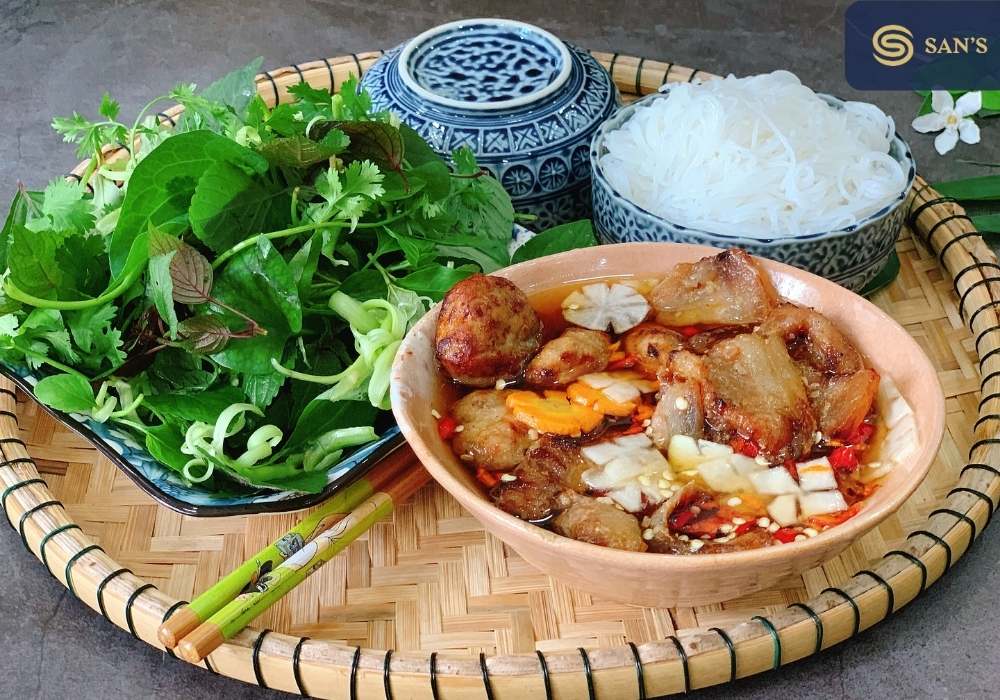Vietnamese cuisine is a tantalizing tapestry of flavors, textures, and aromas that has charmed its way into kitchens and hearts around the globe. Balancing the principles of yin and yang through its ingredients, it harmoniously blends sweet, salty, spicy, and sour, resulting in dishes that are as nourishing as they are delectable. Amidst the rich culinary landscape of Vietnam, one dish, in particular, has captivated both locals and travelers alike – the iconic “bun cha.”

Hailing from the bustling streets of Hanoi, “bun cha” is more than just a meal; it’s a symphony of taste. This dish, comprising of grilled pork (often shoulder or belly) over vermicelli noodles, and usually topped with nuts, fresh herbs, and fried shallots, is served with a side of flavorful dipping sauce, showcasing Vietnam’s mastery in creating multi-layered flavors. Celebrated both in its homeland and overseas, “bun cha” isn’t just a testament to the country’s rich gastronomic heritage but also a reflection of its culture, history, and heart.
Historical Roots
The labyrinthine alleys of Hanoi, echoing with tales of ancient dynasties and colonial footprints, are also the birthplace of “bun cha”. While the exact origins of this dish are somewhat elusive, it’s widely believed to have sprouted from Hanoi’s vibrant street food culture, specifically during the early 20th century.
Deeply ingrained in the culinary traditions of Northern Vietnam, “bun cha” has always been more than just sustenance; it’s a cultural emblem.

Historically, street vendors would carry their portable charcoal stoves and ingredients, moving through Hanoi’s alleys to serve freshly grilled pork over a bed of rice noodles to eager locals. The preparation method and the unique combination of ingredients reflected the resourcefulness and creativity of Hanoi’s inhabitants.
Over the decades, “bun cha” has witnessed subtle shifts in its preparation and presentation, as chefs and home cooks infused their personal touches. Originally, the pork was skewered and grilled, resembling kebabs. But with time, many opted for patties, giving the meat a more succulent texture.
Likewise, while the dipping sauce’s base elements – fish sauce, sugar, and vinegar – have remained consistent, variations in ingredients like green papaya or carrot garnish have been introduced, each adding a distinct layer to the dish’s evolving narrative.
Today’s “bun cha” is not just a mere dish; it’s a historical voyage, whisking those who indulge in its flavors through time, celebrating Vietnam’s dynamic culinary journey and the undying spirit of its people.
Understanding the Dish: Ingredients & Preparation
Ingredients:
- Grilled Pork: Often derived from the shoulder or belly, the pork is chosen for its balance of meat and fat, ensuring succulence in every bite.
- White Rice Noodle (Bún): These are thin vermicelli-like noodles made from rice, serving as the soft and neutral base for the dish.
- Herbs: Commonly used herbs include Thai basil, cilantro, and mint, which infuse a burst of freshness and aroma.
- Dipping Sauce (Nước Chấm): This is a flavorful mix primarily consisting of fish sauce, sugar, vinegar, and water, often garnished with chopped garlic, chili, and sometimes green papaya or carrot slices.
Preparation:
- Marinating the Pork: The secret to a flavorful “bun cha” lies in its marinade. The pork, whether in slices or patties, is marinated in a mixture of shallots, garlic, fish sauce, sugar, black pepper, and sometimes a touch of dark soy sauce. This mixture not only seasons the meat but tenderizes it, ensuring it remains juicy upon grilling.
- Grilling Techniques: Traditionally, the pork is grilled over a charcoal flame, which imparts a smoky aroma. The meat is placed on a mesh grill, occasionally basted with the marinade to keep it moist and flipped periodically to ensure even cooking.
- Broth Preparation: The dipping sauce or broth is prepared by dissolving sugar in warm water, to which fish sauce and vinegar are added. This base is then garnished with garlic, chilies, and occasionally slices of green papaya or carrot, lending it depth and layers of flavor.

Regional Variations: While the “bun cha” from Hanoi is arguably the most famous, variations do exist across regions. For instance, in Southern Vietnam, the dish is often sweeter, reflecting the general palate of the region. In some central areas, “bun cha” might come with a side of fried shallots or crushed peanuts, introducing an additional texture to the dish. The consistency and ingredients of the dipping sauce can also vary, with some places using a tangier tamarind base or introducing local herbs unique to the region.
In essence, “bun cha” is a beautiful canvas of flavors, allowing regions to paint it with their unique strokes, resulting in a dish that’s both consistent in its core yet diverse in its expression.
Bun Cha Beyond Vietnam:
As the culinary world has become increasingly globalized, dishes like “bun cha” have found their way from the vibrant streets of Hanoi to the bustling lanes of New York, London, Sydney, and beyond. A dish, once confined to the intimate familial gatherings and local eateries of Vietnam, now graces the menus of upscale international restaurants and fusion food trucks worldwide.
Global Appeal: The allure of “bun cha” lies not just in its exquisite balance of flavors but also in the experience it offers. Its assembly-style serving, allowing diners to personalize their plate by adding herbs, noodles, and meat to their liking, resonates with the global trend of interactive dining.

Moreover, the dish’s wholesome nature – a mix of protein, carbs, and fresh herbs – appeals to health-conscious diners seeking flavorsome yet balanced meals. As international chefs have discovered “bun cha”, many have embraced its essence while introducing their twists, like using alternative meats or gluten-free noodles, making the dish accessible to a broader audience.
Notable Mentions: Perhaps one of the most iconic moments that projected “bun cha” into global limelight was the casual dinner between former US President Barack Obama and the late Anthony Bourdain. In a tiny Hanoi eatery, they sat on plastic stools, enjoying “bun cha” amidst locals.
This meal, captured for Bourdain’s show “Parts Unknown”, showcased the authenticity and richness of Vietnamese street food. The episode not only introduced many to “bun cha” but emphasized its significance in Vietnamese culture. Post this broadcast, eateries globally saw a surge in demands for “bun cha”, and it became a must-try for travelers visiting Vietnam.
Today, as you savor a bowl of “bun cha” in a trendy London restaurant or a cozy eatery in San Francisco, it’s not just a meal you’re partaking in; it’s a narrative – one of traditions, journeys, and the universal love for food that transcends borders.
FAQs:
1. What’s the nutritional value of “bun cha”? A typical serving of “bun cha” offers a balanced meal with protein from the pork, carbohydrates from the rice noodles, and a range of vitamins and minerals from the fresh herbs and dipping sauce. A bowl might contain approximately 400-600 calories, depending on the serving size and exact ingredients. It’s relatively low in saturated fats, given the lean cuts of pork used, and the dipping sauce provides sodium and umami from the fish sauce.
2. I’m a vegetarian. Is there a vegetarian version of “bun cha”? Absolutely! Many places, especially in tourist-friendly areas of Vietnam, offer vegetarian versions of “bun cha”. Instead of pork, they use tofu or seitan, which are marinated and grilled to mimic the texture and flavor of the traditional meaty version. The dipping sauce, typically made with fish sauce, can be substituted with soy sauce or a vegetarian fish sauce alternative.
3. Where’s the best place to try authentic “bun cha” in Vietnam? While “bun cha” originated in Hanoi, and many believe the capital offers the most authentic experience, you can find delectable versions of the dish throughout the country. In Hanoi, the Old Quarter has numerous local eateries serving mouth-watering “bun cha”. For a slice of history, you can visit the restaurant at 24 Le Van Huu street where Obama and Bourdain shared their famous meal. However, every local might have their favorite spot, so it’s always a good idea to ask residents for their recommendations.
4. How is “bun cha” different from “pho”? While both dishes involve rice noodles and meat, they’re quite distinct. “Pho” is a noodle soup with a clear, aromatic broth, typically made from beef or chicken, and served with flat rice noodles. “Bun cha”, on the other hand, features grilled pork served over vermicelli noodles with a separate dipping sauce. The preparation, flavor profiles, and eating experience of the two dishes are very different.
5. Can I make “bun cha” at home? Certainly! Making “bun cha” at home can be a fun and rewarding experience. The key lies in marinating the pork well and achieving a good char on the meat, either by grilling or using a stovetop pan. The ingredients for “bun cha” are increasingly available at Asian grocery stores worldwide, making it easier for enthusiasts to recreate this Vietnamese classic in their kitchens.





